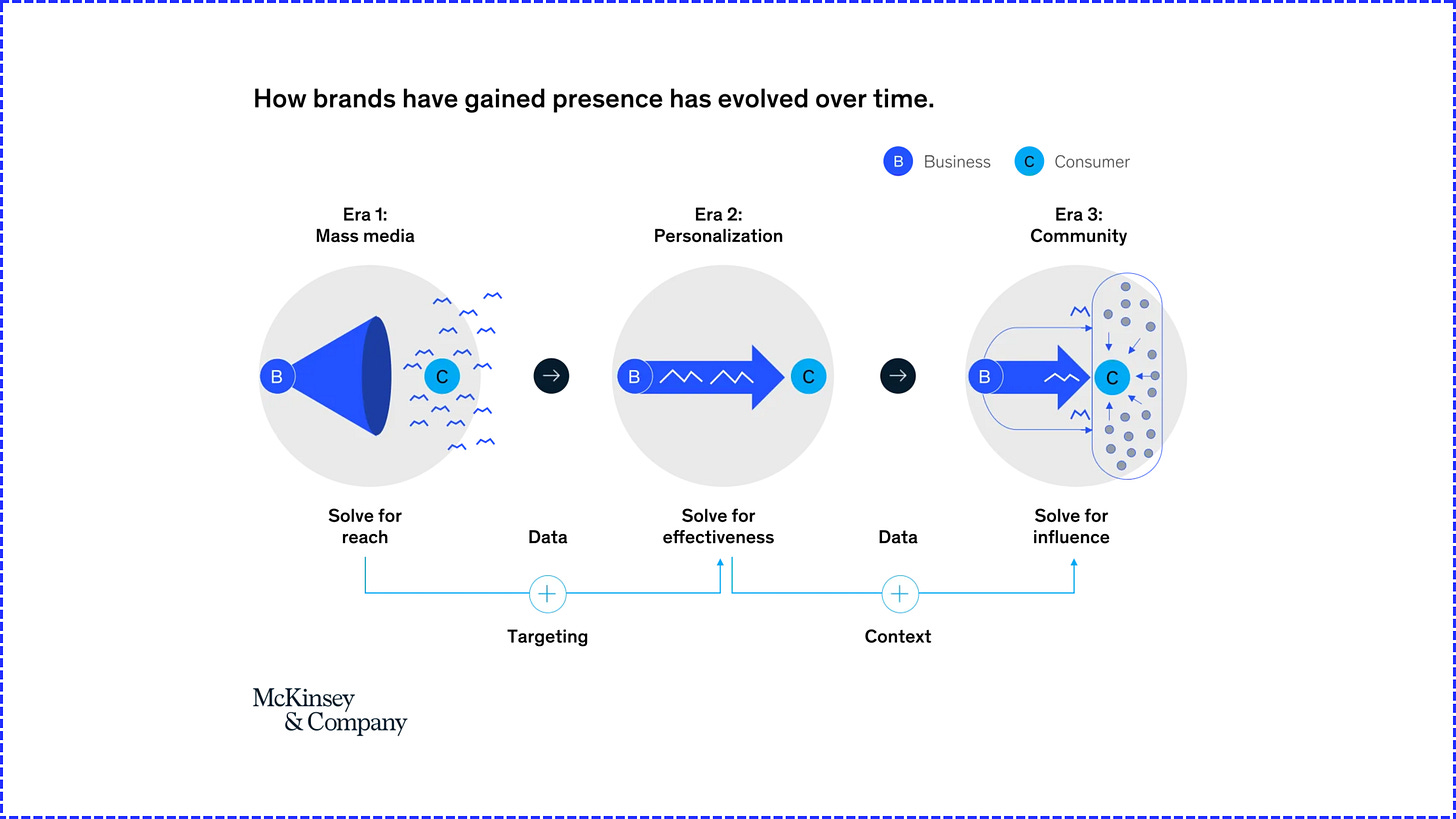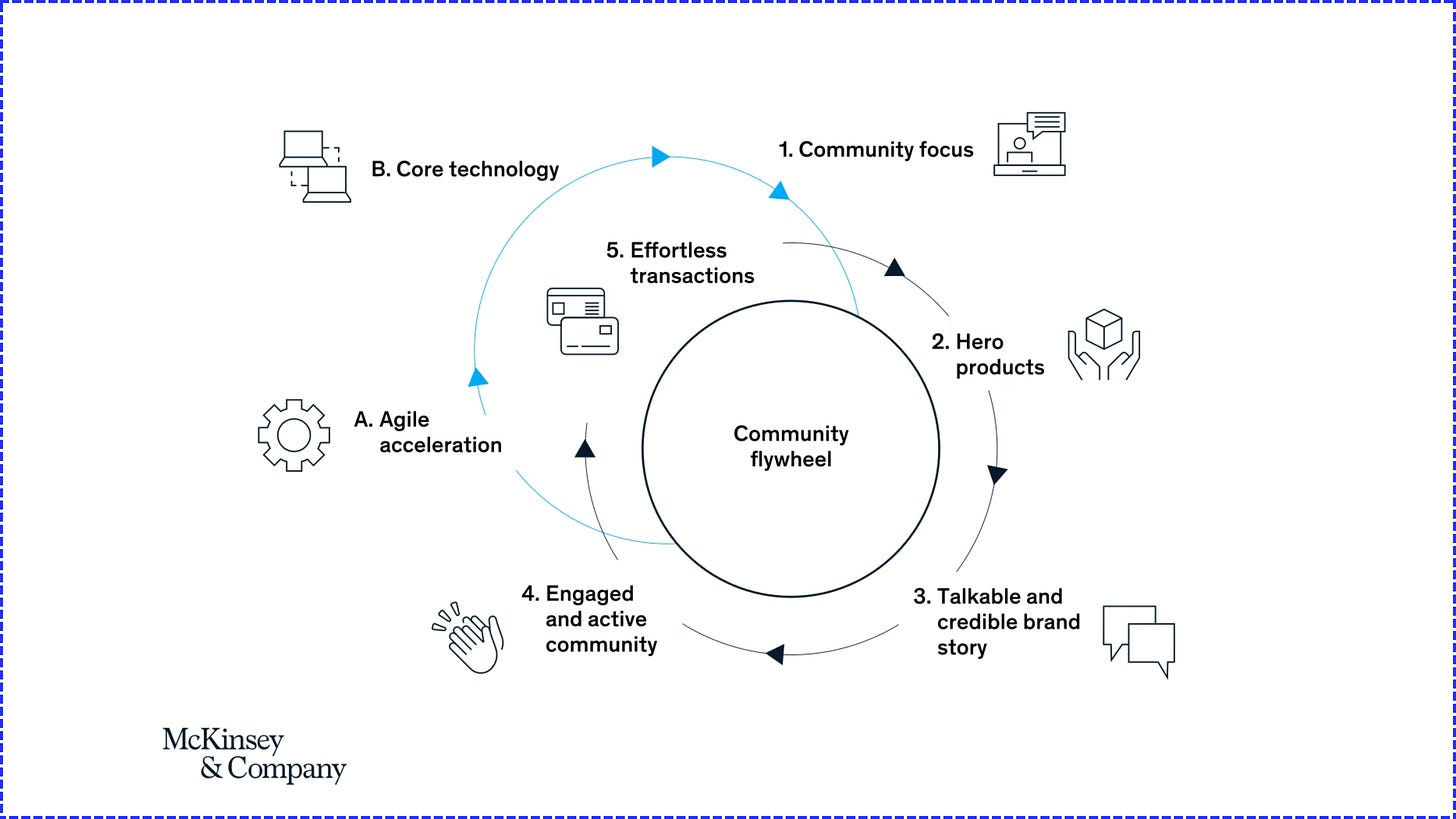🚀 The era of community-led growth has begun
The 2020s and beyond belong to community.
Xin chào! I’m Hien—a full-time builder, community-led growth strategist, and serial founder based in Ho Chi Minh City 🇻🇳
You are reading a ✨ free edition ✨ of Screate Growth Hub—we help builders scale their next million-dollar startups with community, real connections & good vibes—one story at a time, alongside fellow builders in 17 countries (and counting!)
Today, I want to talk about something transforming the way organizations grow: Community-led Growth.
1️⃣ The Pain of Growth Today
Let’s face it—traditional growth strategies aren’t cutting it anymore. Customer acquisition costs are higher than ever. Ads and cold outreach? Overwhelming, impersonal, and increasingly ineffective.
A good product is no longer enough because competitors can copy and solve the same customer needs. Think of how TikTok pioneered short-form video content, only to have Facebook, Instagram, and YouTube adopt the same feature (🤦♀️)
People are sick of automated messages, generic sales reminders, and purely transactional relationships. They’re tuning out.
What they crave is different.
The future of growth isn’t just about capturing attention—it’s about building relationships. It’s about creating unique experiences and value only YOU can provide. And that’s where community comes in.
2️⃣ Why Now? Why Community?
Three major trends are driving this shift toward community:
The Decline of Traditional Marketing: Consumers are overwhelmed with ads and information, both online and offline. With approximately 100 million new businesses starting each year worldwide (Moyak, 2024), it's harder than ever for brands to compete for their attention. At the same time, the customer acquisition cost (CAC) getting higher. To stand out, companies must do more than advertise—they must build trust and foster a sense of belonging (Jocz and Quelch, 2009; Schaefer, 2023).
A New Internet Era: Innovations like Web3, crypto, and NFTs create decentralized, boundary-free ways to connect (Schaefer, 2023). Community gatherings—whether in person or online—are now possible anytime, anywhere, with just a smartphone and Wi-Fi, breaking down geographical barriers.
Loneliness and the Need for Connection: After the COVID-19 pandemic, the need for authenticity and connection has never been stronger. Consumers value authenticity, accountability, and connection (Chillingaryan and Grace, 2022). A recent Gallup & Meta survey on “The Global State of Social Connections” found that 1 in 4 adults feel "very lonely." As Schaefer said in the episode “Community-Based Marketing: The Future of Business” on Social Media Examiner, “51% of Americans aged 18-24 have received medical treatment for their mental health. People are desperate to find connection and community—not to watch more ads or to buy products without purpose.”
People are desperate for connection and community—not more ads or meaningless transactions.
As Schaefer aptly said: "People need communities to belong to and brands need communities to help them cut through the noise."

3️⃣ What Is Community-led Growth, Anyway?
One of the biggest reasons why community-led growth is so fuzzy is that people have different opinions and understandings of the term:
“Community-led growth implies building, cultivating and growing a community of loyal and passionate consumers.” (e.g., Michelle, 2023; Warne, 2022)
“It involves community members in every business decision and thus creates double value.” (Commsor Inc., 2022)
“Being community-led means that community is the engine, not a sidecar, of your business”, Brian Oblinger, strategic community consultant, said in an episode
from In Before The Lock podcast (Kuhl and Oblinger, 2023)
👇 Here’s how I define it:
“Community-led growth is a overarching strategy where the community is the engine of business growth.”
It’s about putting your users at the center—not just as buyers but as collaborators in your journey. You create spaces where your users feel heard, valued, and empowered to succeed, turning them into passionate advocates who fuel your growth.
4️⃣ How a Community Flywheel Works
Unlike the traditional funnel, community-led growth creates a flywheel—where satisfied users fuel growth by becoming advocates who attract even more users and help refine your product, which only delights your users even more.
Here’s how it works:
Spark connections: Identify your most passionate early adopters across channels. Build meaningful relationships with them.
Empower your early adopters: Give them a platform to share their stories, connect, and provide exclusive access to your team and resources.
Leverage the flywheel: Harness feedback, collaboration, and advocacy to continually improve your product and grow your community of users.
The result? A self-sustaining cycle that becomes unstoppable over time.

5️⃣ The Concept of Community-led Growth Isn’t New—You’ve Seen It Before!
Last year, I needed an all-in-one workspace to manage my remote company. That’s when I discovered Lark.
The funny thing is, what convinced me to switch from 10+ other tools and rebuild my whole workflow from scratch wasn’t just the product—it was the community.
What happened was:
“Yeah, I need a new tool for managing my remote company because I have been dizzy with jumping from one platform to another, my meetings aren’t recorded and I don’t have a real-time high-level sense of everything is moving and if they are headed in the right direction”
“Ugh, too many options. I don’t know which to choose…”
“Mhmmm, I am curious about what other people are using. Perhaps I could start narrowing my options from there.”
Searching and reading endless reviews…
Discovered a community of one of the tools, Lark, blooming with relevant use cases, testimonials, and ongoing discussions.
“OMG, I absolutely love it! Why haven’t I found it sooner?”
Long story short, I stumbled upon one of Lark partners’ vibrant community (shout out to anh Tuan & Transform Group for cultivating such an amazing community! 🙌), filled with testimonials, use cases, and ongoing discussions. Suddenly, I didn’t feel like I had just found the right product—I felt like I was joining a movement.
Here’s what I realized:
✅ The product is like the car, but the community is the engine. Together, they create a flywheel of value and advocacy.
✅ People don’t just buy products—they buy outcomes. Seeing how others used Lark to solve their challenges inspired me to envision my own success.
✅ Community lets companies “play their own game.” Two similar products may solve the same problem, but the one with an engaged, passionate community will always win.
This isn’t just true for Lark. Companies like Notion, Canva, and Duolingo have scaled exponentially because of their communities, turning users into their greatest growth engines.
6️⃣ Community-led Growth is a Game-Changer, but It’s Not for Everyone
Community-led growth has the potential to transform businesses, but it’s not a one-size-fits-all solution. Here’s why:
Building a thriving community takes time and intentionality.
As Sharath, former Head of Community at Threado AI, aptly said: “Just because community-led growth is shaping the future of business doesn’t mean you should mindlessly jump on the bandwagon. Community building is a painstaking process that takes time; it’s not a competition, it never was, and it never will be.”
Founder buy-in is essential; without it, efforts often stall.
Successful examples like Notion, Atlassian, UiPath, and Salesforce share a common thread: strong founder support from day one.
Gareth Wilson, in his StartupGTM interview, noted: “Without founder buy-in, creating a sustainable program becomes challenging.”
Startups with product-led growth strategies benefit most from community.
McKinsey & Company confirms that community-led is the best business model in the 2020s, and community flywheel is a method of choice for new startups: “Thanks to the nature of community flywheel, it results in a) a fast feedback cycle of cross-functional agile teams, b) not requiring extensive marketing technology investment ahead of demand, “thereby, enables rapid growth, provides a high return on investment at low risk—and encourages energized high-performing teams”.
Gareth Wilson also explains: “Community-led approaches work exceptionally well with organizations that have a product-led growth strategy, particularly those offering free plans and aiming for broad-based marketing. Communities can significantly support and enhance these efforts… Products that people actively want to share, like Notion and Canva, also benefit greatly from community-led strategies.”
Measuring ROI isn’t always straightforward. In fact, in the beginning, it should not be the only focus.
Ben Lang, former Head of Community at Notion, shared: “Community-building is a long-term investment. Instead of seeking immediate ROI, focus on testing and iterating. A strong community provides passionate fans and advocates, creating a valuable moat around your product.”
7️⃣ When Does Community-led Growth Make Sense? A simple Brand-Community-led-Growth fit framework
So, how do you know if community-led growth is right for your business? Ask yourself:
Are you solving a problem that requires ongoing engagement or education to deliver full value?
Do you value long-term relationships over short-term transactions?
Are you willing to listen and adapt to customer feedback?
Are leaders at your organizations committed to investing in community as a growth engine?
Does your product lend itself to advocacy and sharing among users?
If you answered “YES” to ALL of these questions (yes, I mean all of them, missing one or a “Yeah kinda…” is not acceptable 👩🏻💻), community-led growth could be a game-changer for your organization.
As McKinsey notes in their research: “Brands excelling in community-led growth generate a fast-spinning flywheel, in which advocates drive conversation, engagement, and sales—resulting in sustainable growth at high ROI.”
However, if your organization lacks alignment, resources, or a long-term vision, it may be worth revisiting your readiness before diving in.
📌 My Final Thoughts on Community-led Growth
Community-led growth is a powerful strategy, but it’s not for everyone. It requires time, dedication, and alignment across the organization. For those who embrace it, the rewards can be transformative—turning users into advocates, reducing acquisition costs, and building lasting loyalty.
But for those chasing immediate wins, it may feel more like a marathon than a sprint. And that’s okay—because when you do it right, community-led growth isn’t just a strategy. It’s a movement.
💬 What’s Next?
Over the next two months, I’ll be exploring how top companies like Notion, Canva, and Duolingo have mastered this community-led approach—and how you can replicate their success for your business.
▶️ Request companies, raise questions, and upvote ideas: Here.
This series is for growth leaders, community builders, founders and marketers who believe in the power of community, think differently, and focus on building movements, not just profitable businesses.
Because the era of community-led growth isn’t just coming. It’s here.
If that resonates with you:
Subscribe for bi-weekly-ish insights.
Share this on your socials, in your communities, and within your circles. The more subscribers, questions and upvotes we get, the more targeted and helpful I can make this content. So please share this newsletter—it helps me create even more relevant insights for you!
Leave constructive feedback on this essay to help make it even better.
Together, we can build the future of growth—one discussion at a time.
Let’s grow,
Hien





Which company do you want me to break down next? Let me know ✌️